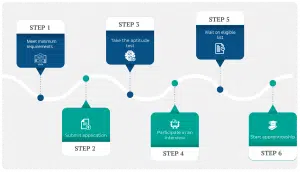The CDA or Child Development Associate credential is a highly recognized and valued accreditation in Early Childhood Education (ECE). The Council for Professional Recognition awards the CDA certification to candidates fostering young children’s physical, emotional, social, and cognitive growth. Obtaining a CDA Credential is one of the first steps in advancing your ECE career.
The CDA test is conducted at the Pearson VUE test center. It evaluates the skills and knowledge of an educator relevant to the learning and development of young children. The test consists of 65 multiple-choice questions, five of which are scenario-based and detail-oriented. Candidates are also required to prepare a professional portfolio and partake in a verification visit.
Did you know?
There are four specialty CDA tests that candidates can choose from depending on their field of work in ECE: 1. Toddler, 2. Preschool, and 3. Family Child Care. Each test consists of a total of 65 questions: 60 multiple-choice questions and 5 scenario-based questions.
CDA Question Types Explained
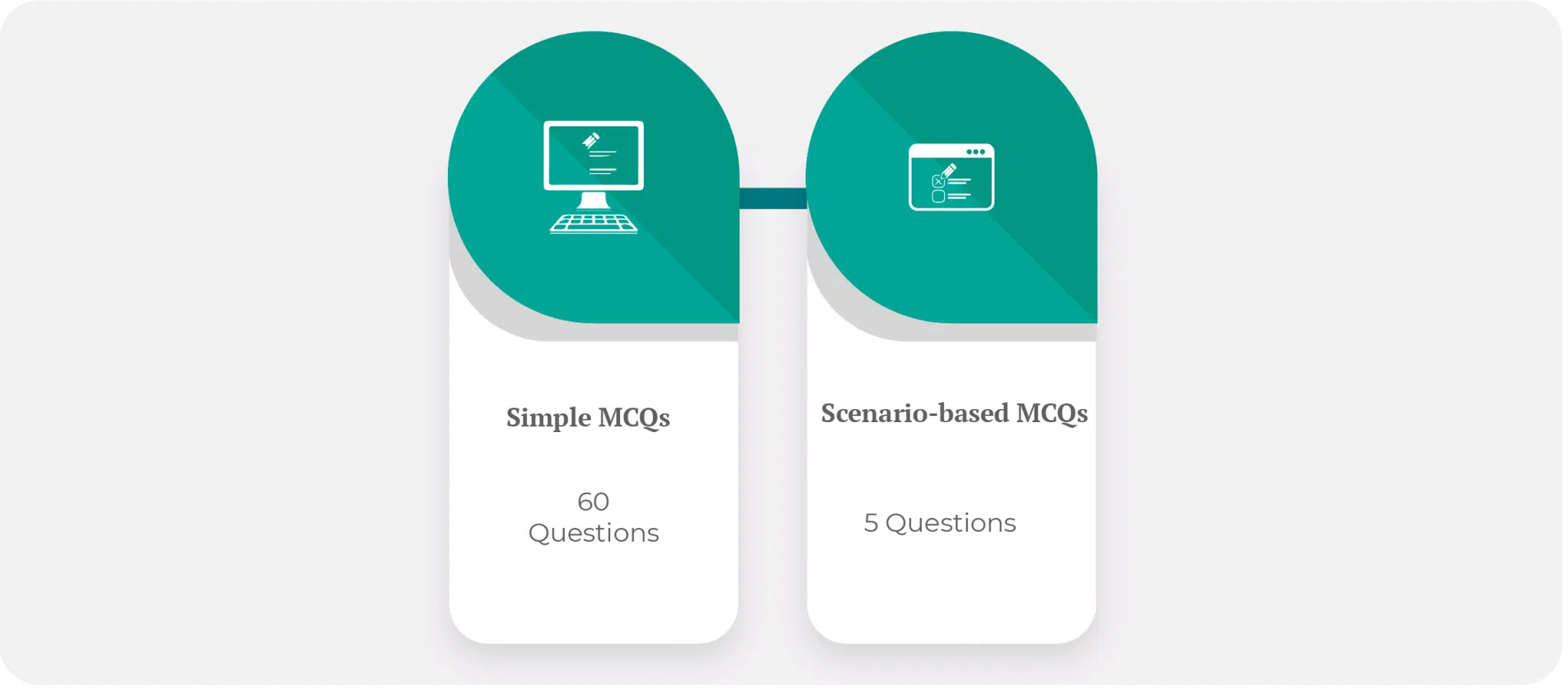
The Child Development Associate Test is a computer-based exam held at the Pearson VUE test center. It includes 65 multiple-choice questions which must be completed in one hour and 45 minutes. Candidates are given an extra 15 minutes to read instructions and practice. The test is available in English or Spanish.
Candidates take the CDA exam for the credential they applied for, whether it be Family Child Care, Infant-Toddler, or Preschool. Each CDA specialty has a similar pattern of 65 MCQs divided into simple and scenario-based questions.
| Type of Questions | No of Questions | Time Limit |
|---|---|---|
| Simple MCQs | 60 | 1 hour 45 minutes |
| Scenario-based MCQs with Narrative and Photo | 5 | |
| Instruction and Practice time | – | 15 minutes |
| Total | 65 | 2 hours |
The test evaluates 13 CDA functional areas which are divided into six competencies to judge a candidates’ efficiency level. These are:
| Competency | Functional Area |
|---|---|
| Establish and maintain a healthy learning environment | 1. Safe 2. Healthy 3. Learning environment |
| Promote physical and intellectual competence | 4. Physical 5. Cognitive 6. Communication 7. Creative |
| Support social and emotional development | 8. Self 9. Social 10. Guidance |
| Establish positive relationships with families | 11. Families |
| Ensure the program is well-run and goal-oriented | 12. Program management |
| Maintain professionalism | 13. Professionalism |
CDA Exam Simple Multiple-Choice Questions
The simple MCQs are relevant to the type of exam chosen. Each test has 60 general questions based on a wide range of subject matter according to the different program settings. Candidates get the exam as per the setting they chose in the Sign Up form.
Winning Tip
Unanswered questions are marked as wrong so it’s advisable to attempt to answer all questions, even if you have to take a guess. This can enhance your score and increase your chances of passing the test.
Here is a sample CDA simple MCQ question:
Sample CDA MCQ question
Which of the following is most likely to help a child who avoids sand texture play in the sandbox?
- Telling the child he should participate as the rest of the children do.
- Telling the child’s friends that he is scared and having them encourage him to try.
- Empathizing with the child’s apprehension but explaining there is nothing to be afraid of.
- Encouraging the child to try on his own terms.
The correct answer is D.
Encouraging the child to try on his own terms – Encouraging the child to take a gradual approach to sand play can help to reduce fear or anxiety. This approach can involve playing with the sand in a way that the child feels comfortable with, such as playing with a toy on the edge of the sandbox, and gradually increasing their level of interaction with the sand over time. This approach allows the child to become more comfortable with the texture of the sand without feeling pressured or forced.
A. Telling the child he should participate as the rest of the children do – This approach may make the child feel pressured and forced to participate, leading to further anxiety or reluctance to engage in sand play.
B. Telling the child’s friends that he is scared and having them encourage him to try – This approach may lead to embarrassment for the child and may not be effective in reducing fear or anxiety related to sand play.
C. Empathizing with the child’s apprehension but explaining there is nothing to be afraid of – While empathy can be helpful, telling the child that there is nothing to be afraid of may not address their concerns and could potentially invalidate their feelings.
CDA Exam Scenario-based Questions
The test also contains five scenario-based MCQs. These are narratives with a photo followed by a question. Candidates are required to choose the best option based on the information they are given.
Scenario-based questions convey situations describing the conditions faced by an educator in the learning process or comprehensive development of a child. An evaluation is made based on the candidates’ skills and knowledge. It judges their decision-making and competency levels.
Winning Tip
Analyze the narrative and photo carefully before jumping to a conclusion. Sometimes there is more than one correct option. The purpose of the exam is to check your judgment skills so take time to understand the scenario. It’s best to tackle these questions first to avoid last-minute judgment pressure.
Here is a sample CDA scenario-based question:
Sample CDA scenario-based question
You are a teacher at a daycare center and you have noticed that one of your three-year-old students, Emily, has recently started displaying aggressive behavior towards her classmates. She has been pushing, hitting, and taking toys away from other children. When you speak to Emily’s parents, they are surprised by her behavior and do not know how to address it. How can you as a teacher help Emily and her parents address this behavior in a positive and effective manner?

- Consider implementing a punishment strategy such as taking away some of Emily’s toys and privileges in order to discourage her disruptive behavior.
- Encourage Emily’s parents and yourself to take a deep breath and wait for the behavior to change. Ignoring Emily’s disruptive behavior will provide her a cue that it is unwanted behavior that should not be carried out.
- Talking to Emily’s parents and collaborating on strategies to promote positive behavior both at home. These behaviors are likely to influence her behavior at daycare.
- Partially restrict Emily from playing with other children. Emily would be allowed to observe other children playing and learn from their positive behavior.
The correct answer is C.
Talking to Emily’s parents and collaborating on strategies to promote positive behavior both at home and daycare is the most effective and positive way to address the issue. It’s important to understand that children’s behavior is often shaped by their home environment and parenting style. Collaborating with parents can help in identifying any issues at home that may be contributing to the behavior, and parents can work with the teacher to implement consistent positive strategies both at home and at daycare.
A is an incorrect response as punishment strategies are generally not effective in changing negative behavior in children. It is important to avoid punishing the child as it can lead to feelings of shame, guilt and may worsen the behavior.
B is also an incorrect response. Ignoring Emily’s disruptive behavior may not work as it provides no guidance for the child to learn positive behavior. It may also negatively affect the other children who are being affected by Emily’s behavior.
D is also an incorrect response. Partially restricting Emily from playing with other children may cause her to feel excluded and may worsen her behavior as a way to get attention. This approach may also negatively impact Emily’s social and emotional development.
CDA Preparation Strategies
Various online platforms recommend different study resources and preparation tips for candidates. The CDA has established a syllabus and the subject matter to cover. But your testing experience will improve if you follow the right preparation strategies.
You will also be better prepared for the test if you use these preparation strategies:
Plan Strategically
Create a study and preparation plan. Make a timeline of all the topics that need to be covered. Schedule your written exam wisely to give yourself enough time for test preparation. Since the test is candidate-driven, you get six months from the date of receiving the Ready to Schedule Notice to take the exam.
Use Up-To-Date Study Resources
The Council for Professional Recognition recommends several study books and resources that will help you pass the CDA. The council mandates buying a CDA Competency Standards book that contains all the essential information regarding the CDA certification process. Each CDA specialty has its own dedicated edition of the book.
You are advised to purchase study resources at least six months before the exam date and use them in conjunction with an online preparation course. This will ensure comprehensive preparation. If you prepare in advance, you must also stay updated on the council’s official website for the latest study material.
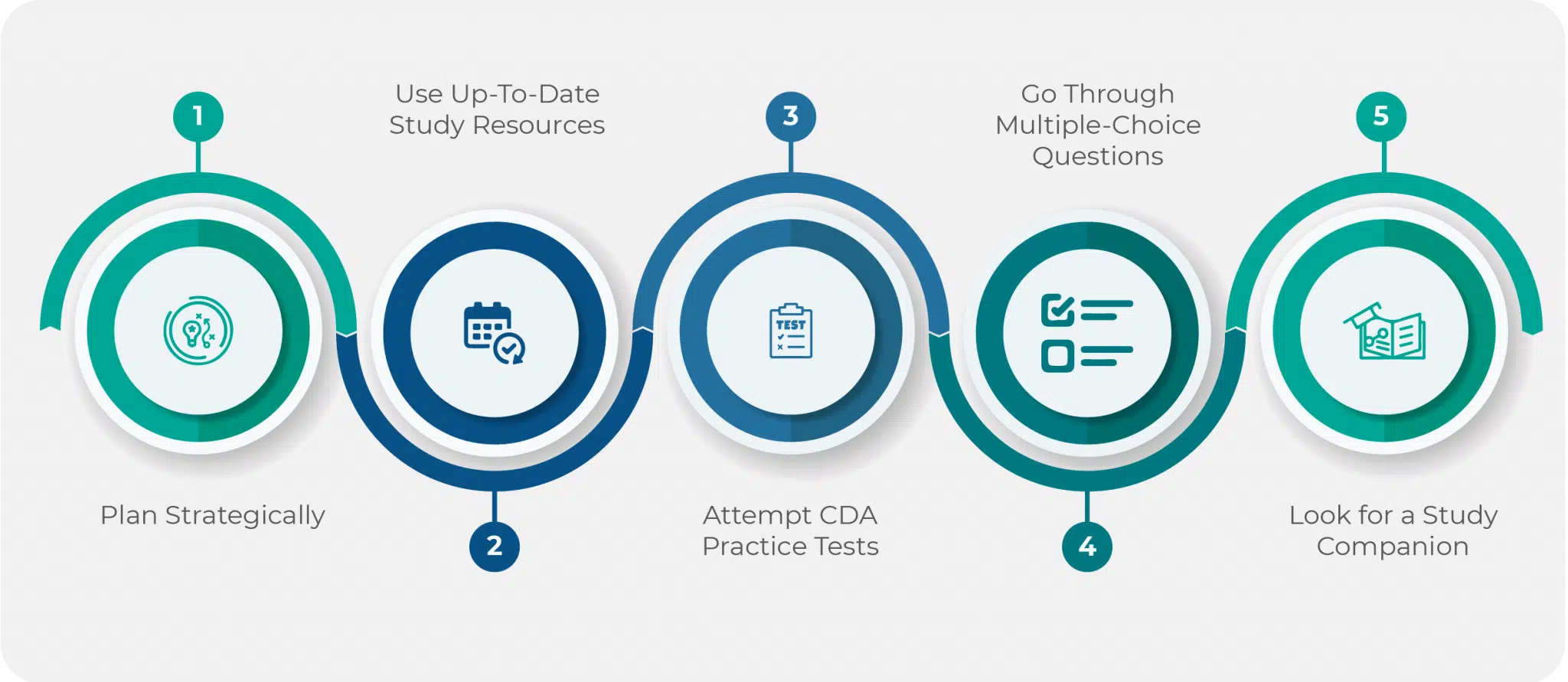
Attempt CDA Practice Tests
Candidates should take CDA practice tests as often as possible to increase familiarity with the exam questions and patterns. There are several workbooks, textbooks, and other CDA practice tests available online. iPrep offers exhaustive course material with a practice test at the end of each guide and full-length CDA mock exams.
Go Through Multiple-Choice Questions
Practice enough MCQ questions to familiarize yourself with the techniques of solving them. This will enable you to provide answers quickly and efficiently. Extensive practice drills in answering MCQs can help you eliminate options faster and make educated guesses.
Look for a Study Companion
Find someone to study with. It is always beneficial to work in a team. A person preparing for the same exam will be there to discuss questions and doubts. They will provide a different perspective on the materials and resources.
Test Features
Test Fast Facts (tl;dr)
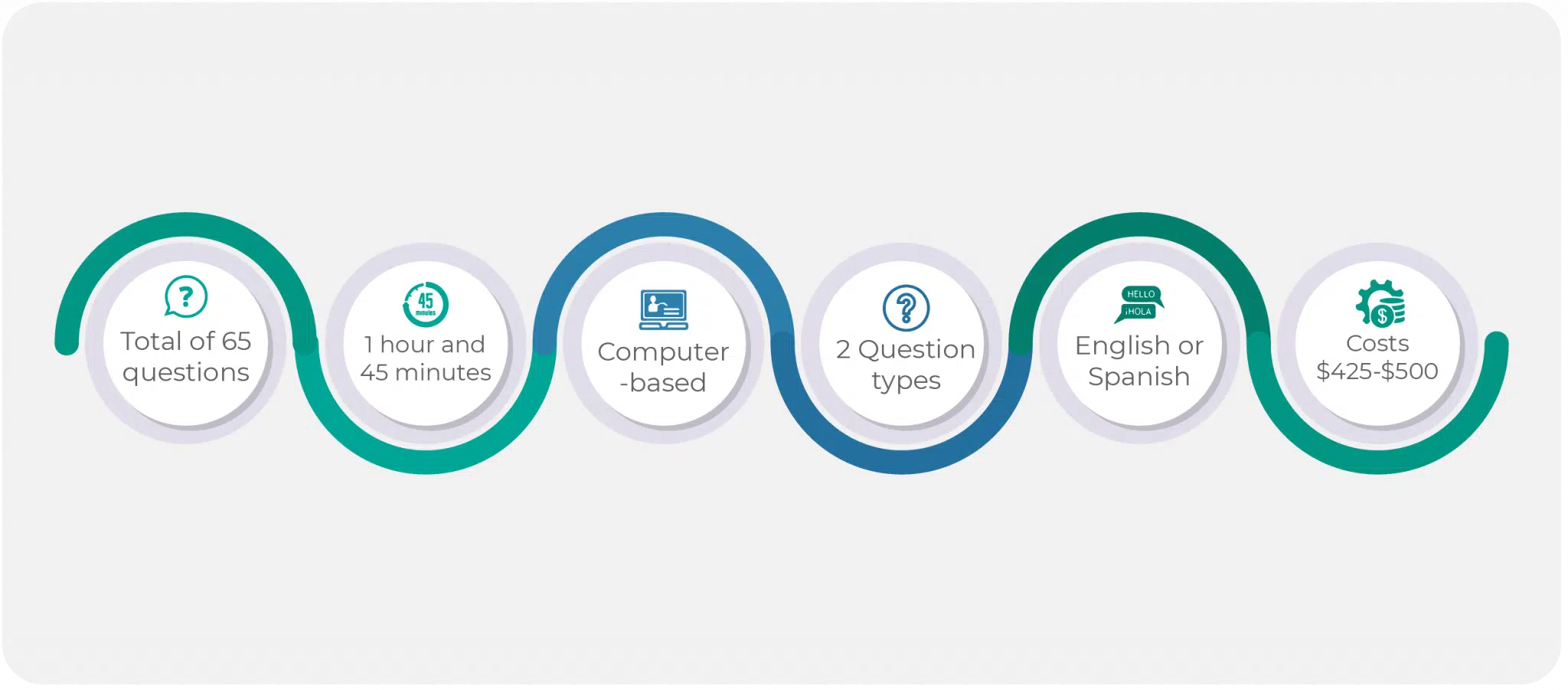
- The CDA certification exam is a computer-based test comprising 65 MCQs about best practices in early childhood education.
- There are two sections
- Simple MCQs – 60 questions
- Situation-based MCQs with an image and narrative – 5 questions
- The test takes about 2 hours to complete
- 15 minutes for instruction and practice
- 1 hour 45 minutes of test time
- The computer notifies you when 30 minutes are left and again when 10 minutes are left.
- The Council for Professional Recognition is authorized to grant a CDA credential. It makes the final decision based on the cumulative score of all assessment sources.
- The CDA test is administered at the Pearson VUE testing center. The staff provides approved accommodations.
- Candidates must schedule their CDA exam through Pearson VUE only.
- The exam is presented in two languages: English and Spanish.
- All candidates must carry a valid photo ID and sign the Candidate’s Rules Agreement before taking the test.
- After applying, candidates receive a Ready to Schedule Notice from the Council. They must take the test within six months of receiving that Notice.
- The CDA credential must be renewed every three years.
- To be eligible for the test, candidates are required to:
- Complete 120 clock hours of professional ECE covering child growth and development (setting specific), with no fewer than 10 hours in each of the eight subject areas.
- Accrue 480 hours of experience working with children within the last three years (setting specific) as paid staff or a volunteer.
- Complete a Professional Portfolio (including the family questionnaires).
- Candidates can earn a CDA in over twenty-five languages including American Sign Language.
- The CDA certification costs $425 for online applications and $500 for paper applications.
- Candidates can cancel their CDA test 24 hours before the appointment on the Pearson VUE online account. A $15 fee is charged for each cancellation.
Regular MCQ Questions vs. Scenario-Based Questions
The CDA specialty exam consists of a total of 65 questions. The questions are divided into two sections:
i) Regular MCQs – 60 MCQ-based questions focusing on best practices in early childhood education.
ii) Scenario-based questions – 5 scenario-based questions consisting of an image and a short story. Candidates are required to answer each question based on the resources they are provided with.

The 8 CDA Subject Areas
The CDA subject areas refer to the specific knowledge and skills that a candidate for the CDA credential must demonstrate in order to meet the requirements of the CDA program. The following table introduces the 8 CDA subject areas.
| CDA Subject Areas | Examples | |
|---|---|---|
| 1 | Planning a safe and healthy learning environment | Space planning, safety, first aid, health, nutrition, equipment, play, materials |
| 2 | Advancing children’s physical and intellectual development | Social sciences, mathematics, motor skills, dual language learning, language and literacy, discovery, art, music, science, technology |
| 3 | Supporting children’s social and emotional development | Socialization, adult modeling, self-esteem, cultural identity, self-regulation, conflict resolution |
| 4 | Building productive relationships with families | Communication strategies, parent involvement, home visits, referrals, conferences |
| 5 | Managing an effective program operation | Reporting, planning, community services, record keeping |
| 6 | Maintaining a commitment to professionalism | Professional development, advocacy, ethical practices, networks, workforce issues, goals |
| 7 | Observing and recording children’s behavior | Tools and strategies for objective observation and assessment of children’s behavior and learning, individual education plans, developmental delays, intervention strategies |
| 8 | Understanding child development and learning principles | Usual developmental expectations for children from birth through age five, early brain development, individual variation (including children with special needs), cultural influences on development |
Common Names of the Test
CDA is an abbreviation for Child Development Associate. Although it is commonly known as the CDA credential, people often recognize it by other names, such as:
- CDA
- Pearson VUE CDA Test
- Child Development Associate Certification
- CDA Certification
- Child Development Associate Credential
- CDA Credential
- Child Development Associate Test
- CDA Test
- Child Development Associate Exam
- CDA Exam
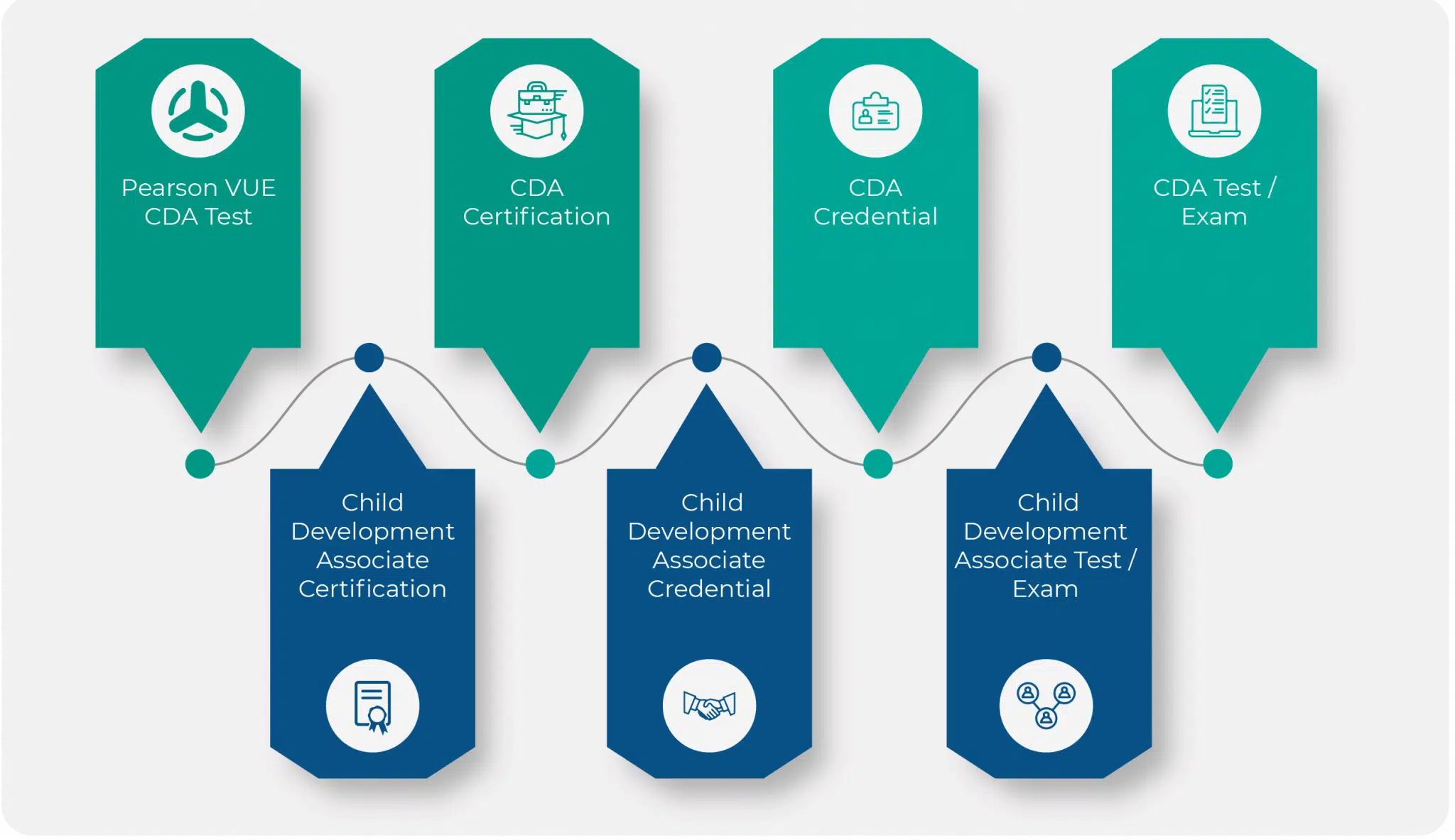
Three CDA Credential Types
Candidates applying for the CDA certification must choose from three types of credential specialties according to their field in ECE:
- Preschool
- Infant-Toddler
- Family Child Care
Candidates must have 480 hours of experience working in the particular specialty field they chose in their application within three years of applying for the CDA credential.
The exam for all three specialties has the same duration and number of questions; however, the syllabus varies according to the CDA course type. The three exams have 65 questions each, spread across their specific subject range to be completed in one hour and 45 minutes.
Type-1: Preschool
You can get a CDA Preschool certification by working with a group of at least eight children (aged three to five years) in a state-licensed child development center. The program must have a minimum of ten children enrolled with at least two caregivers working with the children regularly.
The CDA preschool exam comprises 65 multiple-choice questions covering a range of topics such as health and safety practices, learning environments, behavior management, and personal development.
Some topics for the CDA Preschool exam include:
Health & Safe Environments
- Teaching preschoolers about wellness and safety practices
- Creating a risk-free environment
- Meeting preschoolers’ nutritional needs
- Promoting good health and hygiene
Learning Environments and Schedules
- Providing developmentally appropriate learning materials
- Creating a stimulating environment
- Establishing daily and weekly routines for a child care center
Childhood Development and Behavior
- Promoting self-identity and self-concepts
- Encouraging the development of gross and fine motor skills
- Creating supportive environments and addressing challenging behavior
- Developing literacy and language skills in young students
- Nurturing cognitive development
- Using materials and activities to foster social development and fuel children’s creativity
Workplace Practices
- Specializing in bilingualism
- Creating a culturally inclusive environment
- Maintaining professionalism in a childcare setting
- Managing preschool programs
- Developing positive relationships with families
- Documenting children’s development and behaviors
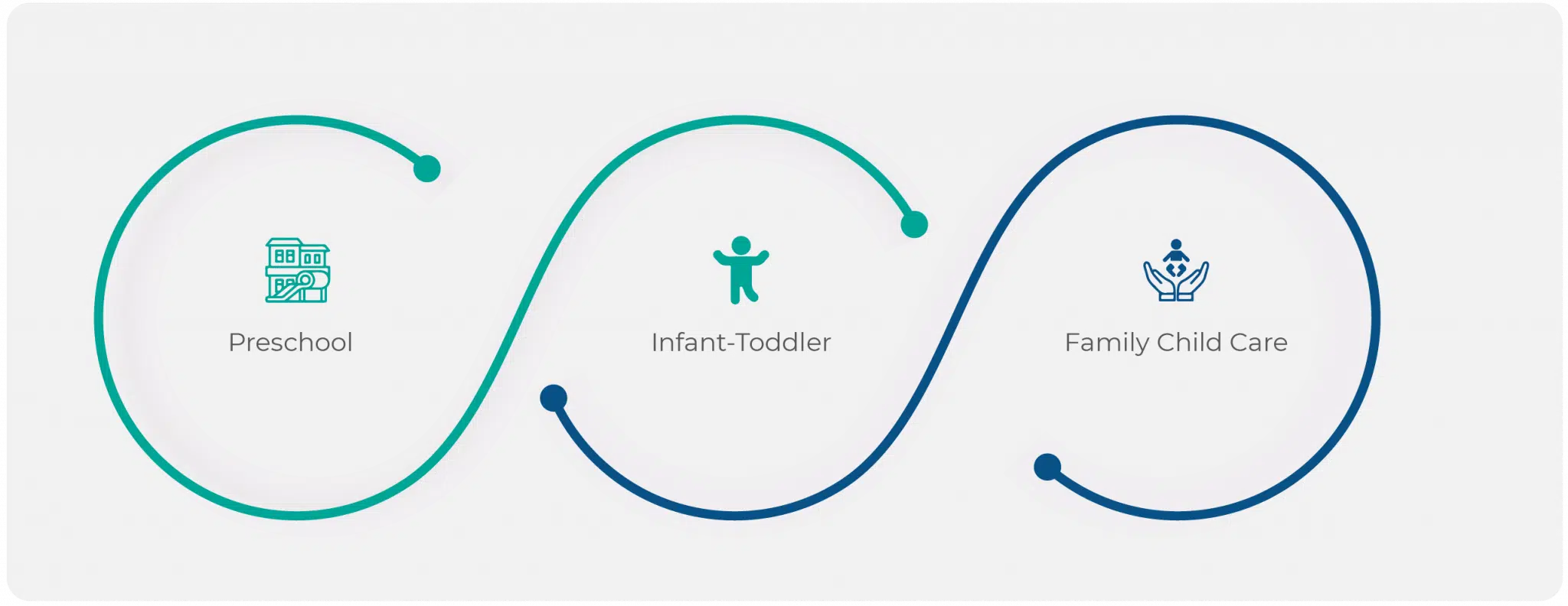
Type-2: Infant-Toddler
A candidate working as a primary caregiver at a licensed child development center with a minimum of three children (aged birth through thirty-six months) will qualify for CDA Infant-toddler certification. The entire center-based program must have at least ten children enrolled, with a minimum of two caregivers working in the center with the children regularly.
The CDA infant-toddler exam entails 65 MCQs revolving around multiple professional childcare techniques and professional practices such as physical, intellectual, social, and emotional development, communicating with family members, etc.
Some topics for CDA Infant/Toddler exam include
- Physical and intellectual development
- Social and emotional development
- Creating learning environments that are safe and encourage learning
- Communicating with family members
- Heath and nutrition in childcare settings
- Behavior management
- Scheduling and program management in childcare settings
- Bilingual specialization
Type-3: Family Child Care
To Qualify for the CDA Family Child Care certification, a candidate must work with at least two children (aged five years or younger) in a family child care home where there is no blood or marriage relation between the candidate and the children. The child care home must meet minimum state and local regulations unless it is located in a place with no regulation of family child care.
The CDA Family test contains 65 MCQs based on the 13 CDA Family functional areas and includes topics such as family rapport, observation and recording behavior, child development, learning principles, etc.
Some topics for the CDA Family exam include
- Family rapport
- Observation and recording behavior
- Professional commitment
- Safe environments
- Program operation
- Physical and intellectual development
- Child development and learning principles
- Social and emotional development
Technical Facts
CDA Credentialing Pre-Requirements
ECE or Early Childhood Care and Education workers in center-based family child care or home visitor programs are evaluated by the Council for the CDA credential awarding process. Candidates are required to fulfill specific requirements regarding their level of education and experience in the early childcare categories. These include:
- Eighteen years of age or older
- A high school diploma or GED
- A high school junior or senior enrolled in a high school career/technical program in ECE
- Having 480 hours of experience working with young children in the same age group and setting as chosen in the CDA application
- Having 120 clock hours of formal child care education with ten hours in each CDA subject area.
CDA Certification Process
The CDA certification is a four-step process that includes preparation, application, exam, and earning the credential. After completing all the steps, the candidates receive a final cumulative score that determines whether they’ve qualified for the CDA credential.
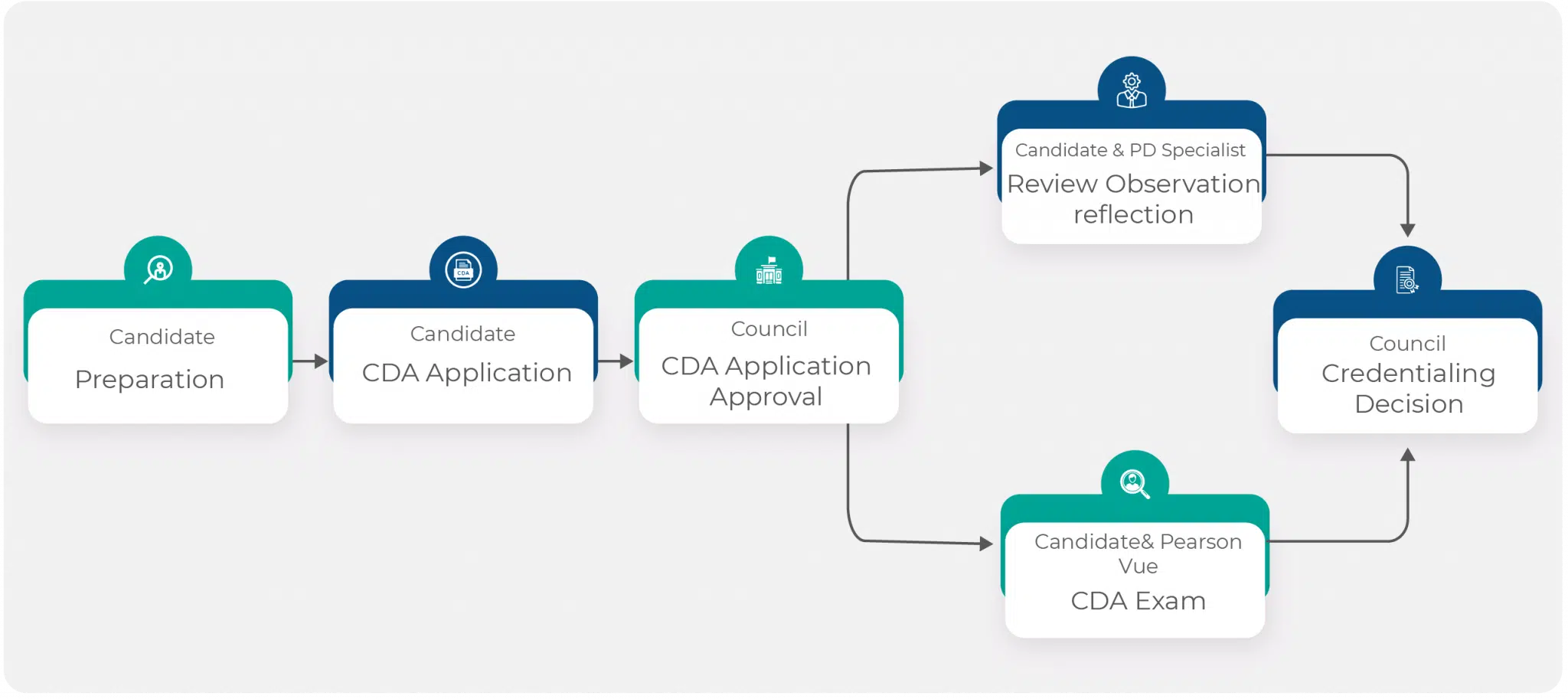
Step 1: Prepare
Candidates applying for the Child Development Associate exam are required to assemble a Professional Portfolio that includes the following:
- Various pieces of documentation
- Resource Collection
- Six Competency Statements
- A Professional Philosophy Statement
They must also find a PD specialist who is trained and certified by the Council to conduct CDA verification visits.
Step 2: Apply
You can apply online through the Council’s website (www.cdacouncil.org/yourcda) or through a paper application which can be found at the back of your Competency Standards book. Once you submit the Sign Up form and pay the application fee, you will receive a Ready to Schedule Notice email from the Council. You must schedule your exam and PD Specialist verification visit by the deadline given in that email.
Step 3: Complete the CDA Exam and Verification visit
The CDA exam is a computer-based exam that takes place at the Pearson VUE testing center. It consists of 65 MCQs that must be completed in a total of 2 hours. The exam duration is one hour and 45 minutes. The first 15 minutes are designed to provide candidates with a window to
- Review instructions
- Agree to the Nondisclosure Agreement stating that you are taking the CDA exam as you applied for CDA and no other reason
- Practice mouse-clicking by answering three practice questions.
You will receive the CDA exam for the type of setting and the language (English or Spanish) you chose in the Sign-Up form as follows:
- Those who applied for the Preschool or the Family Child Care credential will be given the CDA Exam: Children 0-5.
- Those who applied for the Infant/Toddler credential will be given the CDA Exam: Children 0-3.
The candidates are also required to go through a verification visit. There is no particular order regarding the scheduling of the CDA exam and verification visit. However, you must schedule both procedures within six months of receiving the Ready to Schedule Notice.
The verification visit consists of the following three parts:
- A PD Specialist reviews the documents and Professional Portfolio of the candidate.
- They observe the candidate working in the chosen setting with young children for a period of two hours.
- Reflective dialogue occurs between the candidate and PD specialist about professional strengths and setting goals for professional development.
Step 4: Earn the CDA credential
Once the candidates submit the test, it goes directly to the Council for review. The score given by the PD Specialist is combined with the score of the CDA exam to form a cumulative score that determines the guidelines for credentialing.
If the candidate’s final score meets the Council’s requirements, the CDA credential is awarded and mailed to the candidate. If the final score does not meet requirements, candidates are notified and provided with appeals and other options.
CDA Renewal Process
A CDA credential is legally valid for three years. After three years are up, you must renew it, so it remains valid. This ensures that educators stay up to date on ECE advancements. You can submit the renewal application online or on paper no sooner than 90 days before its expiration date.
To submit the renewal application, you must fulfill the following criteria:
- Continued Professional Education in the form of 4.5 continuing education credits (CEUs), or 45 clock hours of child development or ECE training, or three credit hours from courses at an accredited college or university.
- Membership in a national or local early childhood professional organization
- Training and membership verification
- Recommendation from an ECE Reviewer
- Recommendation and verification of 80 hours of work experience
- First Aid and infant and child (pediatric) CPR certification
Once you apply with supporting documents, the council staff reviews them to ensure completeness. On approval, they will award you the CDA Renewal Credential. If the documents are not approved, the Council will notify you so you can resolve the problem within the specified time period.
CDA exam Candidate Rules Agreement
All candidates are required to sign a Candidate Rules Agreement at their respective test centers before sitting for the CDA exam. Those who don’t comply with these rules or refuse to sign the agreement are not permitted to take the CDA test.
As per the agreement, candidates agree to abide by the following rules:
They will not:
- Carry any personal belongings into the testing room. Instead, these will be stored in a locker or container outside the testing room with all electronic devices turned off.
- Bring any food items into the test room.
- Disturb their co-test takers.
- Be allowed to have breaks amidst the exam.
- Discuss the CDA test questions and answers with other test takers during or after the exams.
Apart from these, they will
- Raise their hand to inform the administrator about any hindrance or difficulty during the exam.
- Contact the Council for Professional Recognition after leaving the test center for any queries regarding the exam content.
Please note: The test center will not be responsible for lost, misplaced, or stolen personal items stored in the lockers.
Results Scale and Interpretations
All candidates are required to sign a Candidate Rules Agreement at their respective test centers before sitting for the CDA exam. Those who don’t comply with these rules or refuse to sign the agreement are not permitted to take the CDA test.
As per the agreement, candidates agree to abide by the following rules:
They will not:
- Carry any personal belongings into the testing room. Instead, these will be stored in a locker or container outside the testing room with all electronic devices turned off.
- Bring any food items into the test room.
- Disturb their co-test takers.
- Be allowed to have breaks amidst the exam.
- Discuss the CDA test questions and answers with other test takers during or after the exams.
Apart from these, they will
- Raise their hand to inform the administrator about any hindrance or difficulty during the exam.
- Contact the Council for Professional Recognition after leaving the test center for any queries regarding the exam content.
Please note: The test center will not be responsible for lost, misplaced, or stolen personal items stored in the lockers.
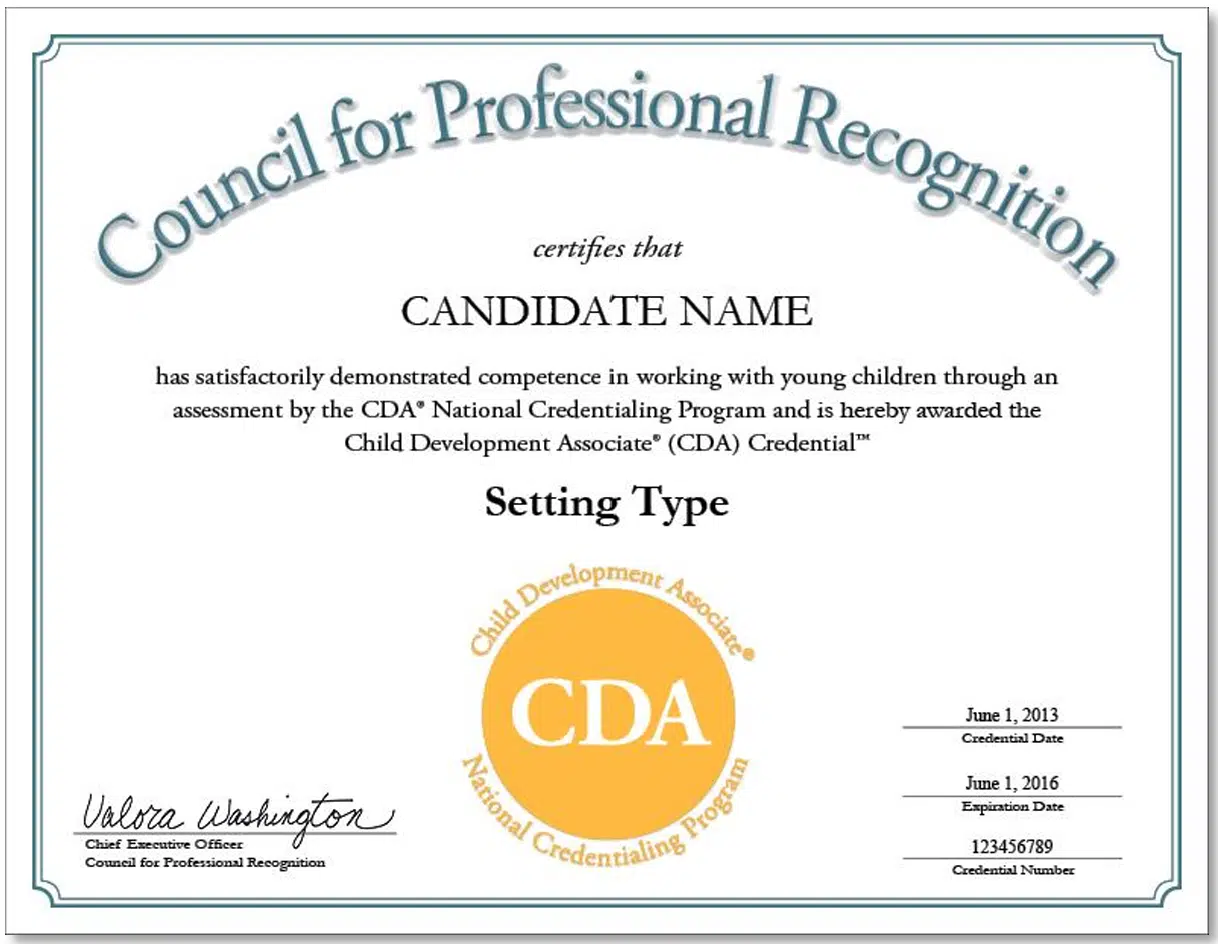
Retake Policy
Those who do not qualify for the Council’s requirements for CDA credentials receive an email letting them know they did not pass. The message will offer guidance on appeals options and retake procedures.
iPREP: Concise. Focused. What you need.
Sign up
Immediate access
Practice
Online self-paced
Pass
Ace that Test!
CDA Test FAQs
The CDA Program is a professional growth opportunity for early educators to demonstrate their skills, knowledge, and abilities in caring for children under the age of 5. The Council for Professional Recognition awards candidates the CDA credential based on their performance in multiple sources, including a portfolio, CDA exam, and observation. The Council assesses the candidates’ competency in 13 different sections to determine if they qualify for the CDA credential.
To apply for a CDA credential, candidates should have the following:
A high school diploma, or status as a high school junior/senior in an early education career and technical Program.
Completed 120 clock hours of professional education across the eight CDA Subject Areas at any time before applying.
Obtained 480 hours of experience as an early educator working with young children within three years before applying.
Prepared a CDA Professional Portfolio as per the requirements defined in the CDA Competency Standards book within six months before applying.
The CDA credentialing process requires a candidate to complete the following:
Fulfill the eligibility and training requirements.
Buy a CDA Competency Standards book that pertains to their work with children.
Provide the requested documents including a professional portfolio, family questionnaires, etc.
Submit a completed CDA application along with the application fee.
Complete the CDA Verification Visit with the help of a PD Specialist.
Take the CDA Exam at the nearest Pearson VUE test center.
The CDA Exam is a computer-based test with 65 multiple-choice questions based on the work of early childhood educators. 60 are simple MCQs, and 5 are scenario-based questions consisting of a short narrative and image. Candidates get one hour and 45 minutes to complete the exam and an additional 15 minutes to read instructions and practice mouse-clicking before the exam.
There are several resources and books available to prepare for the CDA exam. Candidates can take CDA practice tests, like the ones offered by iPrep, to familiarize themselves with the questions and test format. They can also opt for the online study courses available on various platforms like iPrep.
All CDA application fees are due in full at the time of application. These include
The CDA credential application costs $425 for online and $500 for paper applications.
The renewal application costs $125 for online and $150 for paper applications.
Canceling or rescheduling the test can be done 24 hours before the appointment and incurs a $15 cancellation fee each time.
The CDA PD Specialist monitors the CDA Verification Visit with the candidate. During the visit, the CDA PD Specialist:
Reviews the professional portfolio
Observes the candidate working with children
Facilitates a reflective dialogue with the candidate.
The CDA PD Specialist submits the candidate’s scores to the Council within 48 hours of the visit.
Each candidate is required to compile a Professional Portfolio which the PD Specialist reviews. The portfolio comprises
Six reflective statements of competence
Education documentation
Family questionnaires
A professional philosophy statement
Ten resources
Yes, the state may pay for all or part of training and cover the assessment fee for candidates who are income eligible. Candidates can contact the state office to check eligibility and the details of available funding.
There is no specific timeline for the Council to make a credentialing decision. It usually takes 1-3 business days. But if errors are encountered, it could take as long as 4-6 weeks.
The Council sends a courtesy email as a reminder to renew the CDA credential. Ensure that the Council has your current email on file, so you don’t miss the courtesy reminders.
No, the CDA Credential assessment fee is nonrefundable.
CDA Test Tips
Here are some exam tips to help you get through the process smoothly.
1. Stay in touch with Pearson VUE
You can manage your exam details through your Pearson VUE account. Pearson VUE is responsible for all exam-related practices, from scheduling the CDA exam to sending exam confirmation notices so you don’t need to call the Council to schedule the exam or for other matters. Stay in touch with the center and provide your current email address to receive a scheduled exam confirmation notice and other updates regularly.
2. Schedule your exam appropriately
Choose the exam location, test center, and exam date that suits you the best. The Council gives you six months to schedule after you receive your Ready to Schedule notice, so you can ensure you’re well prepared. Make sure your test center is close to your current location for easy accessibility. Check the exam location for parking and other facilities beforehand. Calculate the distance and time required to reach the center to ensure you are not late.
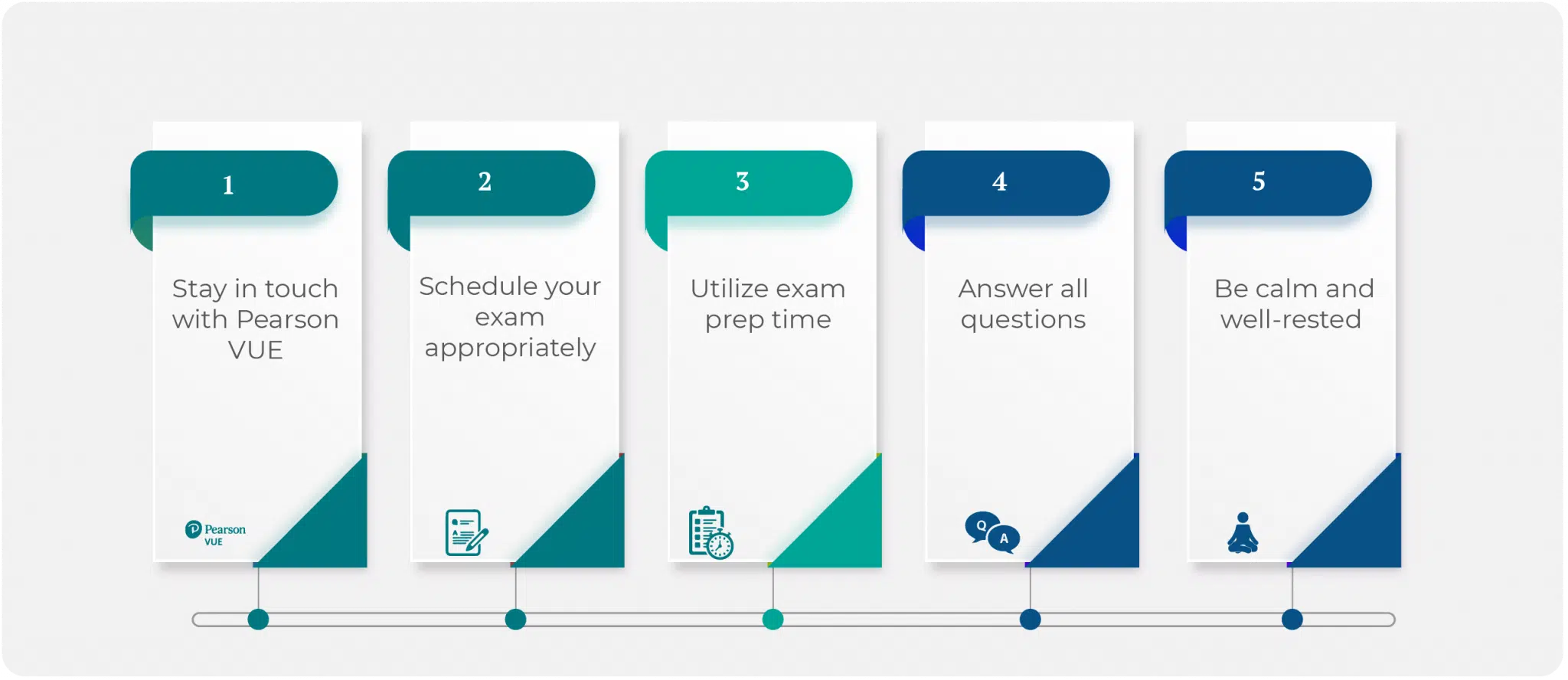
3. Utilize exam prep time
You get 15 minutes to read the instructions and practice the test before the exam begins. Utilize that time wisely by reading the exam instructions carefully, testing your computer, and practicing mouse-clicking before the exam begins.
4. Answer all questions
There are a total of 65 MCQs on the CDA exam. Try to answer all the questions as unanswered questions will be marked as incorrect.
5. Be calm and well-rested
Get a sound sleep and eat healthy to ensure you are alert and ready for the CDA test.
Administration
- Test Location: CDA tests are administered at Pearson VUE testing centers on behalf of the Council for Professional Recognition.
- Test Schedule: Candidates send the Council a Sign-Up form along with the necessary documents to the Council to receive a Ready to Schedule notice. They can schedule their CDA test date, time, and location with the Pearson VUE test center within six months of receiving the notice.
- Test Format: Computer-based exam with multiple-choice questions.
- Test Materials: Since it is taken on a computer, no outside materials are required.
- Cost: Online CDA application costs $425 while paper applications cost $500. All fees are paid in full during application submission. Cancellations must be made 24 hours before the scheduled appointment, and cost $15.
- Retake Policy: Candidates can retake/reschedule the test following the original application procedure.
Test Provider
The Pearson VUE administers the CDA credentialing test on behalf of the Council for Professional Recognition.
The Council for Professional Recognition is a global leader in credentialing ECE (Early Childhood Educators). They assess the candidates to ensure their practices are targeted to enhance child development and growth. The Council awards CDA credentials to candidates who demonstrate competency in all 13 CDA functional areas. The credential helps candidates in career advancement and improves their professional status.
Pearson VUE is an expert testing services provider with a worldwide network of test centers and partnerships with several industries. They conduct millions of exams annually, empowering them to yield certification and licensure programs for well-performing individuals. Pearson VUE ensures secure exam delivery options and innovative testing methods to provide an enhanced experience for the candidates.
Information Sources
Disclaimer – All the information and prep materials on iPrep are genuine and were created for tutoring purposes. iPrep is not affiliated with the CDA Council for Professional Recognition, with Pearson VUE testing centers, or with any other institutes or trademarks mentioned in this article.
Free CDA practice test: Get to know what the Child Development Associate (CDA) test will be like by practicing with these sample questions:
Question 1 of 5
You have a student in your class, 8-year-old Michael, who is struggling with his reading skills. He becomes easily frustrated during reading time, and has started to act out in class as a result. How might you best address this behavior?
- Work with Michael to develop an individualized plan that includes extra one-on-one support during reading time.
- Give Michael a break during reading time to participate in a calming activity before returning to the lesson.
- Implement a reward system for Michael to encourage him to keep trying and improving his reading skills.
- Assign Michael to a more advanced reading group to challenge him and boost his confidence.
The correct answer is A.
Working with Michael to develop an individualized plan that includes extra one-on-one support during reading time is the best approach. This will allow Michael to receive personalized attention and guidance to help him develop his reading skills, and will help him feel supported and understood in the classroom.
The other answer options may not address Michael’s underlying needs and may even exacerbate his frustration and acting out behaviors.
B – While it’s important to help Michael manage his frustration and stress during reading time, simply giving him a break to participate in a calming activity may not address his underlying reading difficulties. Michael may still struggle with reading when he returns to the lesson, which could lead to further frustration and acting out behaviors. A more effective approach would be to work with Michael to identify strategies and techniques that can help him improve his reading skills and manage his frustration and stress during reading time.
C – While it’s important to encourage and motivate students, implementing a reward system alone may not be effective in addressing Michael’s underlying difficulties with reading. Michael may feel pressured to perform to earn rewards, which could exacerbate his frustration and acting out behaviors if he is unable to meet the expectations. Additionally, a reward system may not address the root cause of Michael’s struggles and may not provide the support and guidance he needs to improve his reading skills.
D – While it’s important to challenge students and build their confidence, assigning Michael to a more advanced reading group may not be the best approach for addressing his difficulties with reading. Michael may feel overwhelmed and discouraged if the reading material is too challenging, which could lead to further frustration and acting out behaviors. Additionally, this approach may not provide Michael with the individualized support and guidance he needs to improve his reading skills.
Question 2 of 5
Jack and Jill are siblings who constantly argue and fight over toys, TV shows, and other things. Jack is the older sibling and tends to dominate most situations, while Jill often feels left out and overlooked. Their parents are getting frustrated and want to help the siblings learn how to get along better.
- Separate Jack and Jill and give them individual attention to avoid competition.
- Ask Jack to give Jill what she wants to make her happy and avoid conflicts.
- Talk to the parents about strategies they can use at home to encourage positive sibling relationships.
- Teach Jack and Jill how to compromise and work together to find mutually acceptable solutions.
The correct answer is D.
Teaching Jack and Jill how to compromise and work together to find mutually acceptable solutions is the best way for their parents to help them resolve their conflicts and improve their relationship.
Option A, separating Jack and Jill and giving them individual attention to avoid competition, is not the best approach as it may lead to feelings of favoritism and further fuel their competitive behavior. It is important to teach Jack and Jill how to work together and find ways to share and cooperate.
Option B, asking Jack to give Jill what she wants to make her happy and avoid conflicts, is not the best approach as it reinforces an unhealthy power dynamic in their relationship. It is important to encourage Jack and Jill to communicate and find mutually acceptable solutions instead of one-sided compromises.
Option C, talking to the parents about strategies they can use at home to encourage positive sibling relationships, is not the best approach as it puts the responsibility solely on the parents and does not involve Jack and Jill in the process of resolving their conflicts. It is important for Jack and Jill to learn how to work through their conflicts and build positive relationships on their own.
Overall, teaching Jack and Jill how to compromise and work together to find mutually acceptable solutions is the best way for their parents to help them resolve their conflicts and improve their relationship. This involves fostering open communication, encouraging empathy and understanding, and promoting collaboration and mutual respect between the siblings.
Question 3 of 5
You are a CDA in a preschool classroom with 4-year-old students. You have noticed that one of your students, Maya, seems to be struggling with basic literacy skills like recognizing letters and sounding out words.
What approach can you take to support Maya’s literacy development?
- Assign Maya additional reading and writing tasks during class time to help her catch up to the other students.
- Encourage Maya to practice literacy skills through interactive, play-based activities and games.
- Advise Maya’s parents to hire a private tutor for her to receive additional literacy support.
- Ignore Maya’s literacy struggles as it may discourage her and focus on other areas of development.
The correct answer is B.
The best approach to support Maya’s literacy development is encouraging Maya to practice literacy skills through interactive, play-based activities and games.
Play-based learning is a proven effective way to promote literacy skills in young children. Through play, children can learn the basic skills of literacy, such as recognizing letters and sounds, in a fun and engaging way. Encouraging Maya to practice literacy skills through interactive, play-based activities and games will allow her to develop her skills in a way that is enjoyable and effective. This approach can include games like scavenger hunts where she has to find letters, word games where she has to sound out words, and interactive stories where she can participate in reading and writing.
Option A, assigning Maya additional reading and writing tasks during class time, may not be the best approach as it may feel overwhelming and tedious for her, especially if she is already struggling with basic literacy skills. This may discourage her and further perpetuate her struggles.
Option C, advising Maya’s parents to hire a private tutor for her, may not be the most appropriate approach as it may create additional pressure and stress for Maya, and it may not address the root of the problem. Furthermore, it may not be financially feasible for all families.
Option D, ignoring Maya’s literacy struggles, is not a good approach as it may lead to further struggles and delay in her literacy development. It is important to address areas of struggle and provide support to help children succeed in all areas of development.
Question 4 of 5
Which of the following statements best demonstrates verbal sensitivity to a child’s feelings?
- “You seem upset that you can’t go outside to play. We have to wait until recess to go outside and play, but in the meantime, let’s find something else fun to do inside.”
- “Stop crying and whining. We will go outside to play after lunch, and that’s final.”
- “I can see that you’re feeling sad because we can’t go outside right now. It’s tough when you can’t do what you want to do. Why don’t we have a snack together and then see what we can do inside?”
- “I know you’re disappointed, but crying and yelling won’t help. Let’s finish lunch, and then we can talk about what we can do inside.”
The correct answer is C.
This option addresses the child’s feelings, acknowledges their emotions, and helps them find a way to cope with their sadness. Naming the child’s feelings can help them understand and cope with their emotions in a safe and healthy way. It also offers an alternative activity to help the child feel better.
Option A is a good option because it acknowledges the child’s feelings and suggests an alternative activity, but it could be more specific and direct in addressing the child’s concerns.
Option B is not sensitive to the child’s emotions and instead commands the child to stop crying and whining, which could escalate the child’s emotions.
Option D recognizes the child’s disappointment but is not as sensitive as option C. It also does not offer an alternative activity to help the child cope with their emotions.
Question 5 of 5
How can you help your toddlers become more independent during meal times?
- At this age, you can’t. They can feed themselves and that’s all they need to know.
- Encourage them to set the table, pass food to one another and participate in the cleanup process.
- They should become active in preparing the food and cooking, which will drive them to eat it themselves.
- None of the above.
The correct answer is B.
Encouraging toddlers to set the table, pass food to one another, and participate in the cleanup process can help them become more independent during meal times. By giving toddlers simple tasks to complete, they learn responsibility and gain a sense of accomplishment. Additionally, allowing toddlers to make choices about what they eat and how much they eat can also foster independence.
Option A is not the best approach because toddlers should be encouraged to learn and develop new skills at their own pace. Setting restrictions on what they can or cannot do might limit their potential. Some toddlers can definitely be more active in meals besides eating independently.
Option C is not the best approach because it is not developmentally appropriate for toddlers to be actively involved in food preparation and cooking, as it can be dangerous and they may not have the necessary skills to handle food and kitchen tools safely.
Option D is not the best answer because there are ways to help toddlers become more independent during meal times, as explained in option B.
Sample Flashcards
Boost your exam prep with these key concept flashcards.
Well done!
You have completed the Sample Questions section.
The complete iPREP course includes full test simulations with detailed explanations and study guides.
‘…TESTS THAT ACTUALLY HELP’

In the first 30 minutes of use I have learned so much more than skipping along the internet looking for free content. Don’t waste you time, pay and get tests that actually help.
Richard Rodgers
January 28, 2020 at 7:49 PM
About the course
Welcome to this comprehensive course designed specifically to prepare you for the Child Development Associate (CDA) Exam. Your journey through this course will equip you with the necessary skills and knowledge to successfully pass the exam and move forward in your early childhood education career.
To begin, let’s dive into an overview of the CDA Exam. The Child Development Associate (CDA) Credential™ is the most widely recognized credential in early childhood education (ECE) and a stepping stone to career advancement in the field.
The CDA Exam is a comprehensive test, assessing candidates on their understanding of the fundamentals of child growth and development, maintaining a safe and healthy learning environment, advancing children’s physical and intellectual growth, supporting children’s social and emotional development, building productive relationships with families, observing and recording children’s behavior, and managing an effective program operation.
The exam itself is composed of several sections, each focused on a different aspect of early childhood education. Understanding the layout and expectations of these sections will be crucial in your preparation. In this course, we’ll guide you through each section and offer strategies for tackling the different types of questions you may encounter.
17
Learning hours
4
Practice tests
260
Questions
30
Day access
One aspect of the test that often presents a challenge is time management. The CDA Exam is timed, meaning you will need to answer questions quickly and effectively. Throughout this course, we’ll discuss techniques for managing your time during the test, ensuring that you have the chance to answer every question to the best of your ability.
The aim of this course is to not only provide you with the knowledge needed to pass the exam but also equip you with a strategy for study and preparation. By following the guidance provided in each chapter, you will be able to systematically approach your preparation and ensure that you are ready come exam day.
Finally, this course concludes with a self-assessment. This assessment is designed to gauge your current level of understanding and readiness for the course and the exam. While the results of this assessment do not impact your progress through the course, they can be a helpful tool in understanding your starting point and tracking your improvement throughout your preparation.
Remember, this course is self-paced and self-served, and it’s crucial to take the time you need to fully grasp each concept and practice each skill. The goal is not just to pass the exam, but to develop a deeper understanding and mastery of the principles of early childhood education.
Let’s get started on this journey together. We are excited to support you in reaching your career goals in early childhood education.
Skills you will learn
Child Development
Class Management
Family Engagement
Professional Maintenance
Curriculum
- Course Introduction
- Study Guide & Subject Refresh
- Getting Ready For the CDA Exam
- Mock Tests
- Post-Mock Test Analysis
- Course Conclusion
- Appendix: Additional Resources
Customer testimonial

I actually love using iPrep. I was nervous about choosing a job in child care after six years of volunteer experience. After I took the initial practice exam, I had scored an 83% and decided to not only pursue my CDA but also a career in this field. I am very pleased with the materials and I have been able to identify my strengths and weaknesses and pinpoint target areas for my studies. Thank you.
Abigail Maynard
July 10, 2023 at 11:08 AM
Reviews

Sarah K*****
April 4, 2025 at 1:58 AM
This study course is great , I’m loving the arrangement of the content: the answer explanations fostered by the flash cards

Anusha B****
March 16, 2025 at 12:40 PM
I am really glad that I found this course. What I like from each question is that we will receive an explanation providing valuable insights into the reasoning behind the correct answer. This is a fantastic way to deepen your understanding of the subject. I would recommend iprep course for CDA.

Meilin H***
March 15, 2025 at 2:43 PM
The CDA test prep resource was incredibly helpful in preparing me for the exam with confidence! It provided clear, concise study materials that covered all key competency areas, along with practice questions that closely mirrored the actual test. The explanations were easy to understand, and the study guides helped me focus on essential concepts without feeling overwhelmed. I highly recommend this resource to anyone looking to pass their CDA exam on the first try!

Lidia S********
February 11, 2025 at 12:35 AM
Complete and interesting online course. It cover all topic that you need to get better score in the real test.

Partha K*********
January 7, 2025 at 11:42 PM
The practice tests for the CDA exam covers all the key areas necessary for certification, including areas like child development, learning environment, health & safety, and professionalism. The topics are well-organized and closely aligned with the actual CDA certification training that I went through.

Shereeta H*****
December 11, 2024 at 11:20 AM
This test helped me prepare for my CDA testing in so many ways and I passed my test ? I would recommend this for anyone that’s preparing for this kind of testing . It really helped me have a lot of knowledge about what to expect on the test I give 10 thumbs up ??

Maria P**
October 9, 2024 at 6:09 PM
Excellent ayuda para el examen del CDA , espero tener éxito en mi examen que muy pronto voy a realizar ,

Samanthi S****
August 8, 2024 at 2:29 AM
I got through the exam and thank you so much for the guidance. It is helpful that the I prep gives the time frame so we can do practice with the time. The exam was tough.

Fatima A****
July 31, 2024 at 4:06 AM
It really helped me to understand the pattern of the test and gives me confidence by doing mock test thank you.

Esmeralda M*******
July 2, 2024 at 12:06 AM
The course is everything that I needed, and I was looking to be ready for my test. The course is easy and simple to understand, very happy with my purchase.
